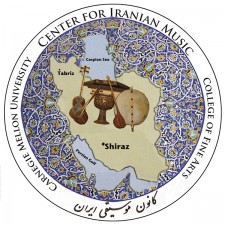Concepts & Terminology
Radif = repertoire. Each master has his own repertoire. Each instrument has a specific repertoire. There are specific repertoires for vocal music as well as for instrumental music.
19th century Radif-hâ = the Radif of Mirza Abdollah for Târ and Setâr, the Radif of Mirza Hosseingholi for Târ, the Radif of Habib Somaiy for Santoor.
20th century Radif-hâ = the Radif of Abolhasan Sabâ for Santoor.
Vocal Radif-hâ = The Radif of Abdollah Davâmi, the Radif of Mahmoud Karimi.
Mâyeh = mode, also Mághâm= mode (in Persian medieval system and also in folk music).
Dâng = tetrachord. Tetrachords are very important in Persian music. Most of the Persian modes are constructed from two conjunct tetrachords plus a whole tone (tetrachord+tetrachord+whole-tone).
Pâyeh = Finalis (quasi tonic).
Shâhed = the most important note (quasi dominant). Note: the Shâhed may not be the fifth degree of the scale.
Ist = the note of stop.
Moteghayyer = changeable, a fluctuating note of the mode.
Âghâz (beginning) = A tone on which the improvisation in a mode begins.
Foroud (descent) = A cadential pattern usually descending to the Finalis. Each Dastgâh has its own specific Foroud patter.
Gusheh (corner) a melodic pattern with a contour and a name. A Gusheh can have the following functions:
1- a variation of the basic melodic pattern
2- a temporary cadential shift to another degree of the mode
3- a complete modulation either to another segment of the mode or to another mode.
Tekke (piece) = a genre piece which can be inserted during the performance of a Dastgâh. A Tekke can be:
1- a melodic genre piece
2- a rhythmic genre piece
3- a text (poetry) related genre piece.
Rhythmic pieces that may be performed during a performance of Dastgâh:
Châhârmezrâb (four plectra, four strokes) = a fast toccata type instrumental piece.
Zarbi (rhythmic) = a rhythmic piece, usually composed and is performed together with the drum(s).
Reng (dance) = an instrumental piece in duple or triple meter usually performed at the end of a performance.
Performance Structure of the Dastgâh:
Pishdarâmad (overture) = a composed instrumental prelude.
Darâmad = introduction, the basic mode is introduced here.
Âvâz = the main body of the Dastgâh consistingof: 1- Gusheh, 2- Tekke.
Tasnif = a composed song usually included during a vocal performance.
Reng = a composed instrumental postlude.
Instrumental and Vocal Techniques:
Tazin (instrumental ornaments). Ornaments are extremely important in Persian traditional music. Each instrument has its own list of specific ornaments.
Tahrir (vocal ornaments). The vocal ornaments of Persian traditional music are one the most advanced and the most complex ornamental forms of vocal music in the world. Also, they are very difficult to learn.
Instruments used in Iranian Traditional Music:
Târ, Setâr, Santoor, Kamânche, Ney, Tombak (or Tonbak), Daf.
Barbat (Oud) = although originally a Persian instrument, this instrument is not frequently used in Persian traditional music.
Gheychak = An ancient instrument which has been used mostly in folk music. However, it has become popular in recent years and has been used in the traditional ensembles.
Instruments used in Iranian Folk Music:
Dotar, Tanboor, Rebâb, Gheychak, Kamânche.

